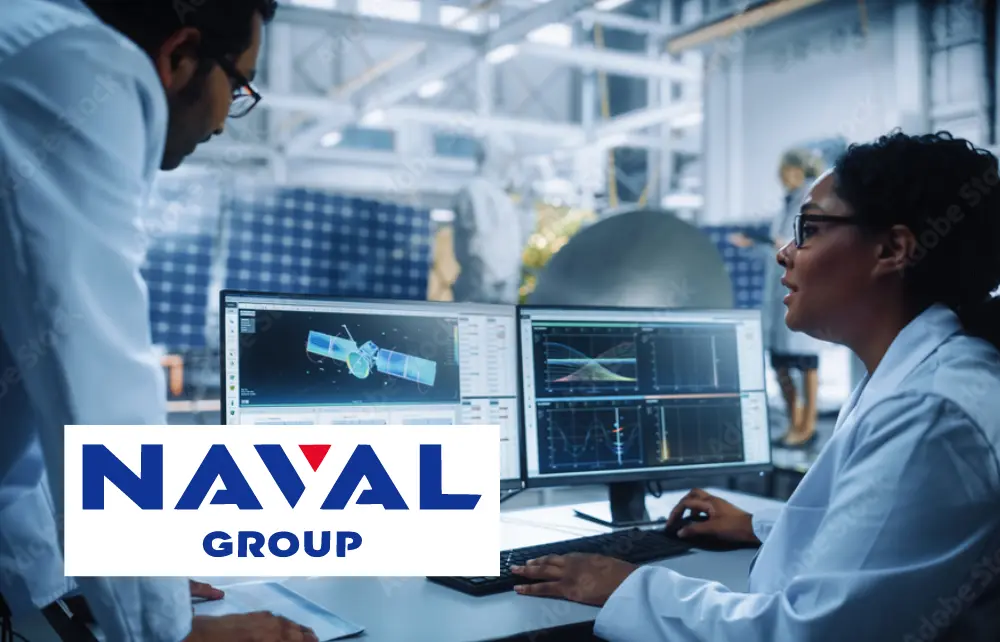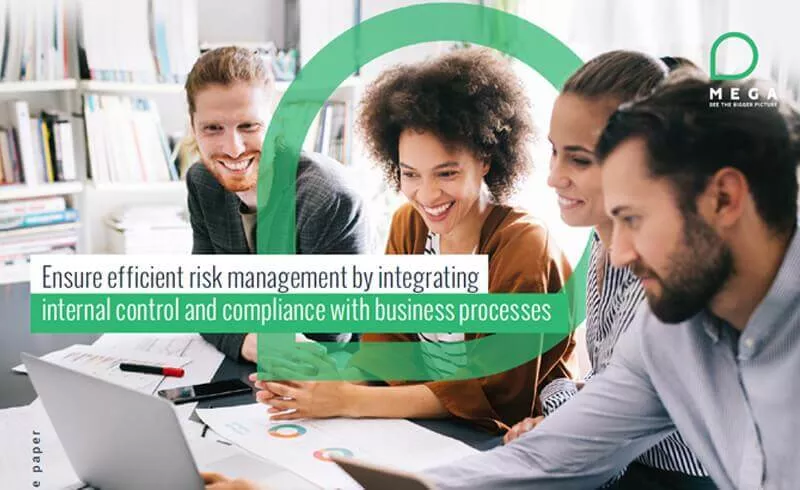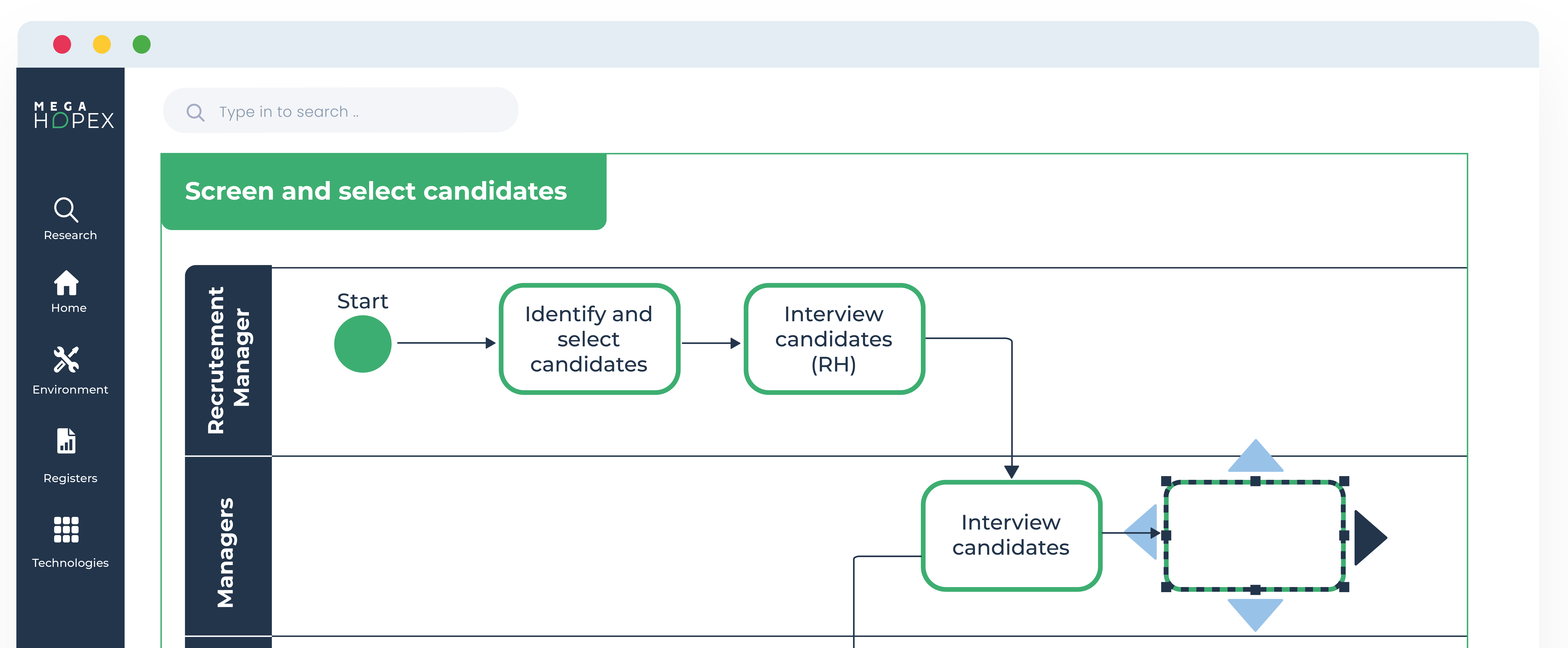
What is Process Mining? Here's a Guide!
Process mining is an emerging research field that has recently gained much attention. It uses data mining, machine learning, and business process management techniques to analyze and improve business processes. In this article, we will discuss the definition, objectives, and benefits of process mining. Through this exploration, readers will better understand what process mining is, how it can be used, and why it has become crucial for businesses today.
What is process mining?
Process mining is an approach that analyzes data from IT systems to gain objective insights and uncover hidden problems. This approach uses software that combines data science and process management to discover, check conformance, and enhance actual processes.
- Discover: The first step is to discover the inefficiencies. The process mining software extracts event logs from information systems such as Customer Relationship Management (CRM) and Enterprise Resource Planning (ERP) tools.
- Check conformance: Next, the process mining tool will review the event logs and turn them into data to identify trends and patterns and automatically create an "as-is" process model that reflects what happens in operations.
- Enhance: Lastly, the software will identify precisely where the bottlenecks and inefficiencies are causing delays and suggest potential reworks. One can also check conformance by comparing actual processes with BPMN models and optimizing them.

How does process mining work?
Process mining is a type of data analysis that looks at existing processes to gain insights and improve them. It works by extracting event logs from existing systems, such as ERP or CRM, which contain information about the execution of a process over time. This information is then used to create process models and visualizations that can be used to identify patterns, bottlenecks, and areas of improvement.
Process mining utilizes data analysis to discover, monitor, and improve fundamental business processes. It works as follows:
- Data collection: Process mining software collects data from various sources, such as process logs, ERP systems, and databases. This data contains information about the steps, events, and actors involved in the analyzed processes.
- Process discovery: The collected data is then used to discover the underlying processes automatically and visually represent them in a process map.
- Process analysis: The process maps are analyzed to identify bottlenecks, deviations, inefficiencies, and other process issues.
- Optimization: Based on the insights gained from the analysis, process optimization suggestions can be made, such as process re-design, automation, and process improvement initiatives.
- Monitoring: Process mining software can also be used for continuous process monitoring, which helps organizations detect and prevent issues before they become serious problems.
As mentioned earlier, process mining software works by extracting event logs (contained in information systems) to construct processes based on three main attributes:
- Case ID: this allows the software to link back an event to a person or a case
- Timestamp: this data point records the time of execution to help sort a sequence of events
- Activity: This attribute corresponds to an activity that was executed in the process
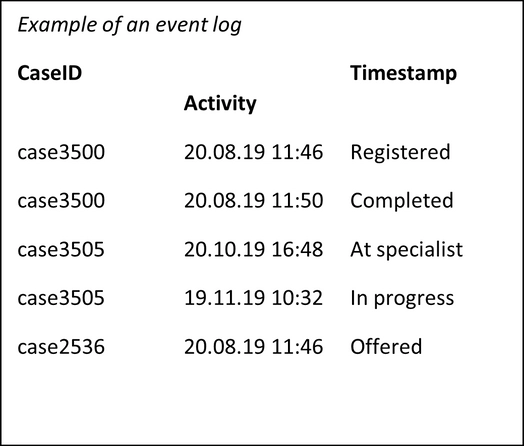
These attributes provide enough detail for the software to identify what stage the process is in. In the example to the right, the phases are “Registered,” “Completed,” “In progress,” or “At specialist.” When an activity is updated for a particular case, the time is also recorded. When looking at the different activities in a macro view, it is possible to construct a process that depicts how cases are entirely handled.
Using the event logs and turning it into data, process mining software can identify deviations, bottlenecks, and waste, or investigate their causes and show ways to improve KPIs such as time, cost, quality, or risk. The result of an analysis may be to add more resources at peak times, or to build in support when bottlenecks tend to occur.
Process mining use cases
Process mining use cases are becoming increasingly popular in the business world as they can be used in various industries and applications to improve business processes.
Some of the most common use cases for process mining include:
- Process Optimization: Using process mining to analyze process data and identify areas for improvement, such as bottlenecks, inefficiencies, and deviations from best practices.
- Compliance Monitoring: Using process mining to monitor processes and ensure they comply with regulations and standards, such as those related to customer data protection, security, and privacy.
- Supply Chain Management: Using process mining to optimize supply chain processes, such as order-to-delivery, by identifying bottlenecks and inefficiencies.
- IT Service Management: Using process mining to improve IT service processes, such as incident management and problem resolution, by identifying inefficiencies and improving response times.
- Human Resources: Using process mining to optimize HR processes, such as recruitment and onboarding, by identifying bottlenecks and inefficiencies.
- Finance and Accounting: Using process mining to optimize finance and accounting processes, such as accounts payable and accounts receivable, by identifying bottlenecks and inefficiencies.
- Customer Service: Using process mining to improve customer service processes, such as complaint resolution and support, by identifying inefficiencies and improving response times.
These are just a few examples of how process mining can improve business processes. The use case will depend on the industry, the analyzed processes, and the organization's goals.
Use Process Mining with Business Process Management (BPM) to optimize efficiency.
Whereas process mining uses data to identify where specific improvements can be made, Business Process Management (BPM) is a discipline focused on aligning processes with business goals. The essential difference between process mining and BPM lies within the outcome. Process mining provides the "as-is" process, while BPM gives a map of the ideal process, also known as the "to-be" process. These two activities are a power pairing as they optimize efficiency, ensure customer satisfaction, and drive operational resiliency.

There are five steps to implement this power pairing and ensure processes are accurate, efficient, and strong:
1. Conduct process mining to identify the “as-is” process.
In this step, one uses process mining tools that can automatically identify inefficiencies hidden in event logs and answer questions like:
- What is causing delays in my process
- Are people adequately trained in doing their tasks?
- Why are some decisions stuck?
Artificial intelligence is a big help in this task. Using machine learning algorithms, process mining tools can compute a combination of different attributes and perform root-cause analysis that helps to identify operational inefficiencies. Root cause analysis is a statistical view that compares a data set with a reference set of data and analyzes the frequency of an attribute between the two data sets.
2. Check conformance to see if the “as-is” process matches what was initially designed.
This step allows process analysts to identify gaps in actual processes and deviations from the norm. Some examples include:
- Ensuring that the same service is provided everywhere to customers is essential. Commonly, branches or sites perform the same process differently. Comparing the logs of the different regions makes it easier to ensure that the process is standardized in every branch.
- Process mining also detects reworks or process loops. One of the reasons for reworks is negligence. For example, invoices that have been incorrectly paid need to be paid a second time, or errors that occur when delivering goods force agents to perform the second delivery. Some process tasks might also be skipped during the execution.
Process mining can help uncover all these issues and understand the reasons. With accurate data from information systems, compliance initiatives are also easier to audit by verifying that the process complies with regulations and policies. Additionally, some business rules can be implemented, so you are automatically alerted when operational KPIs and standards are no longer met.
3. Use process simulation to review different scenarios to identify improvements.
In this step, it is crucial to test processes by simulating multiple scenarios (based on time, costs, and resources) to understand the following:
- What is the impact of adding an extra resource to complete the process?
- What if the allocated time to perform a task is reduced?
- What is the impact on labor costs?
Process simulation enables analysts to simulate different parameters based on statistical models:
- Waiting time for a task: A task is not executed immediately in real life. For example, analysts can model that one case is created every 10 minutes on average for a customer support center with an exponential distribution.
- Processing time: This represents the duration of an activity. It may follow a normal distribution with a mean of 15 min and a standard deviation of 4 min.
- Conditional branch (Gateways): These are modeled by defining the percentage of time the conditional branch is taken when the corresponding decision gateway is reached.
- Resource pool: This indicates who performs each activity in the process model.
- Timetable for each resource pool: This shows the periods during which a resource can perform activities.
By combining all these parameters, analysts can perform “what-if” scenario analysis, compare different scenarios, and implement a strategy that maximizes operational efficiency.
4. Apply an outside-in approach using a customer journey map to identify the most critical milestones in customer satisfaction.
In today's age, it is imperative to have an outside-in approach that shows what it is like to interact with your product from the customers' point of view. To this end, in this step, organizations should use customer journey maps to identify touchpoints (aka interactions) where a customer interacts with the organization. Every touchpoint is rated according to the impact on customer satisfaction, which helps to identify and prioritize which touchpoint/s to improve quickly.
Applying this customer satisfaction lens after the first three steps can help prioritize where and when updates need to get done. An organization will likely have many processes to refine and update if needed. Prioritization ensures the business can continue to thrive and grow while repairing the foundational processes.
5. Strengthen your processes by mapping risks and controls to improve operations.
Lastly, it would be a pity if organizations have come this far (through the first four steps) and have yet to do some housekeeping to strengthen overall operations and apply risk and controls to each process.
A view of the risks within business processes enables analysts to improve and mitigate them. Analysts can use process mining to see why some risks appear in some places.
Learn about Mapping and Monitoring Accountability in the Context of UK SMCR
Process Mining Techniques: Taking Action to Reach Goals
Process mining execution, in particular, refers to implementing process mining techniques to analyze and improve existing processes.
Some of the most common process mining techniques include:
- Process Discovery: Techniques used to automatically discover and map business processes by analyzing process data.
- Process Analysis: Techniques used to identify bottlenecks, deviations, inefficiencies, and other issues by analyzing process data.
- Process Optimization: Techniques to provide data-driven process improvement suggestions and support improvement initiatives.
- Compliance Checking: Techniques used to ensure that processes comply with regulations and standards by identifying and addressing deviations.
- Root Cause Analysis: Techniques used to identify the underlying causes of process issues, such as bottlenecks and deviations.
- Predictive Analytics: Techniques used to use data analysis to predict future process performance and make data-driven decisions.
- Process Simulation: Techniques used to simulate business processes to assess their performance and identify potential improvements.
- Process Visualization: Techniques used to create visual representations of business processes to improve understanding and facilitate analysis and optimization.
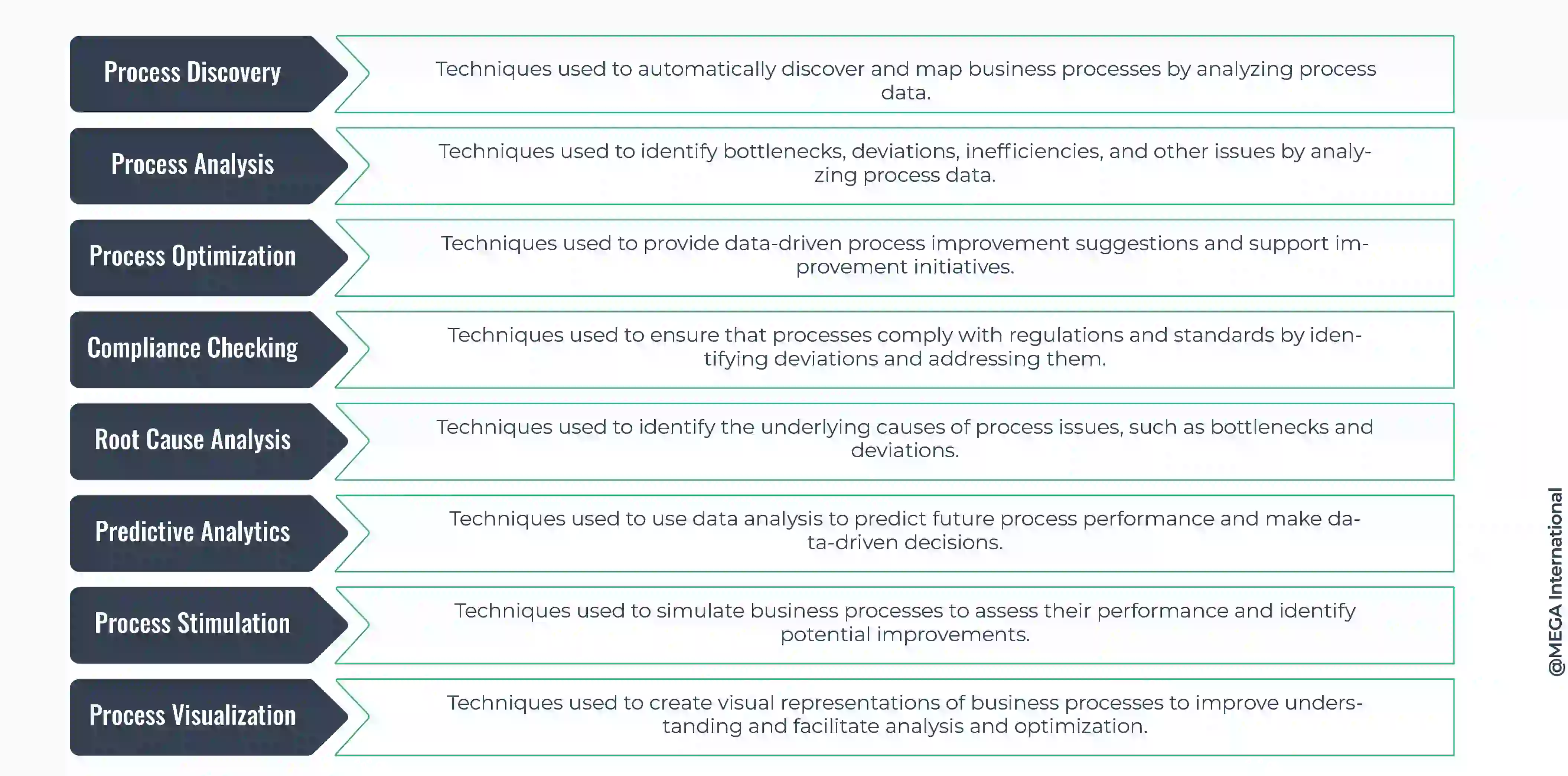
These techniques can be used together or separately to achieve specific goals, depending on the needs of the organization and the processes being analyzed. For example, process discovery and analysis may be used to identify bottlenecks. In contrast, process simulation and predictive analytics may be used to assess the impact of potential process improvements.
Why is process mining software important?
Process mining is an essential tool for any organization looking to maximize efficiency and streamline operations since it allows organizations to increase the transparency and efficiency of their processes.
The following are some of the key benefits of using process mining:
- Improved process visibility: Process mining provides organizations with a clear and comprehensive view of their processes, including bottlenecks, deviations, and inefficiencies.
- Data-driven decision-making: By analyzing process data, process mining enables organizations to make informed, data-driven decisions about process optimization and improvement.
- Increased process efficiency: By identifying and addressing inefficiencies, process mining can help organizations improve the speed, quality, and cost-effectiveness of their processes.
- Compliance: By identifying and addressing deviations, process mining can help organizations ensure their processes comply with regulations and standards.
- Continuous improvement: Process mining enables organizations to continuously monitor their processes and make ongoing improvements, ensuring they remain competitive and efficient over time.
Some of the specific goals of process mining can include the following:
Understanding process flows and identifying inefficiencies.
- Improving process efficiency and reducing waste
- Enhancing process visibility and transparency
- Increasing process compliance and reducing errors
- Identifying process improvement opportunities and making data-driven decisions
- Improving customer satisfaction and service quality
- Reducing costs and increasing profitability
When should you use process mining with business process management?
Process mining technology is particularly effective in improving processes in these use cases organizations have to tackle.
- Procure-to-Pay - Procure-to-Pay enables the integration of the purchasing department with the accounts payable department. It involves four key stages: supply management, purchase order, receiving, invoicing, and payment. Process mining can help eliminate rework and process changes in this process, automate PO closure and low-value invoice processing, and optimize early and late fees.
- Order-to-Cash - Order-to-cash is the business process for receiving and processing customer orders. Process mining can standardize the process and minimize PO changes to facilitate on-time delivery and speed up cash collection.
- Customer Service Desk - A customer service desk provides the customer or end user with information and support related to products and services. Process mining helps organizations standardize their assistance process, remove reworks, and eliminate pending cases. It also analyzes satisfaction in connection to Performance.
- Auditing & Compliance - Process mining helps validate or audit whether current operations conform to defined procedures. More accurate assessments of process deviations and compliance issues, such as segregation of duties, help manage these risks and communicate findings in an audit report.
- Digital transformation - Process mining provides real-time information on how processes perform and how they can be improved using KPIs. Organizations can quickly adapt by continuously monitoring mining data through dashboards and alerts.
- Opportunity for automation (RPA) - It helps organizations discover and assess the prospects for Robotic Process Automation (RPA) by delivering operational data before running into automation.
Button E-Book
This practical guide will provide an effective methodology to conduct process optimization leveraging HOPEX Business Process Analysis with Minit.
Process Mining best practices
Process mining is a powerful tool for improving business processes, but it is essential to follow best practices to ensure the process mining project succeeds. Some of the best practices for process mining include:
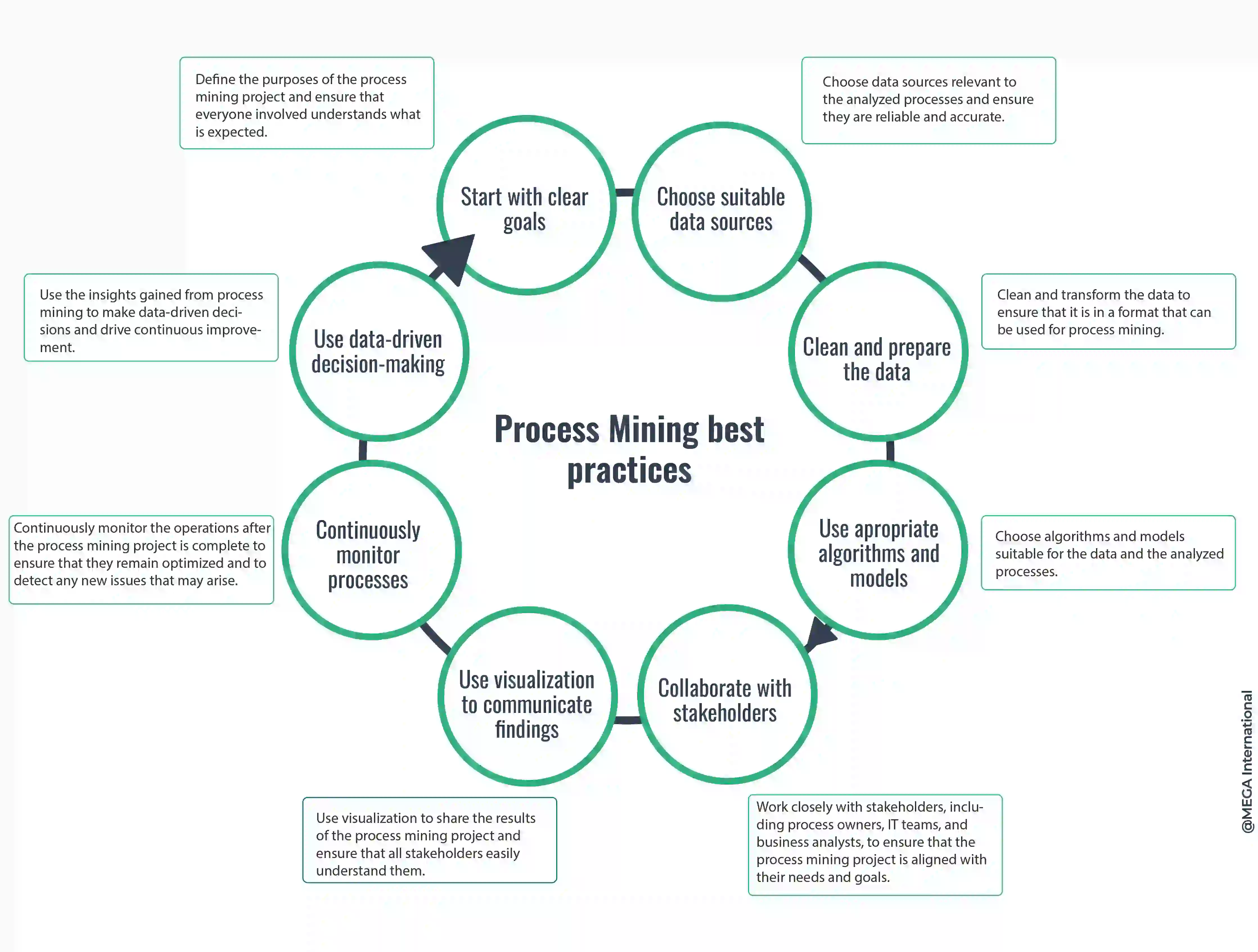
- Start with clear goals: Define the purposes of the process mining project and ensure that everyone involved understands what is expected.
- Choose suitable data sources: Choose data sources relevant to the analyzed processes and ensure they are reliable and accurate.
- Clean and prepare the data: Clean and transform the data to ensure that it is in a format that can be used for process mining.
- Use appropriate algorithms and models: Choose algorithms and models suitable for the data and the analyzed processes.
- Collaborate with stakeholders: Work closely with stakeholders, including process owners, IT teams, and business analysts, to ensure that the process mining project is aligned with their needs and goals.
- Use visualization to communicate findings: Use visualization to share the results of the process mining project and ensure that all stakeholders easily understand them.
- Continuously monitor processes: Continuously monitor the operations after the process mining project is complete to ensure that they remain optimized and detect any new issues.
- Use data-driven decision-making: Use the insights gained from process mining to make data-driven decisions and drive continuous improvement.
By following these best practices, organizations can maximize the value of process mining and ensure that the process mining project succeeds.
Start Your Journey with Process Mining
Want to learn more about how combining Business Process Management with Process Mining can help your organization understand how your processes are executed? Please Request a Demo Today.
FAQs
Process mining uses data analysis techniques to gain insight into the processes used in each organization. It involves using technology to monitor and analyze data related to the activities carried out by an organization.
- Discovery: Process discovery automatically creates a process map by analyzing process data. This process mining type is used to represent a process and understand how it works accurately.
- Conformance: Conformance process mining is comparing the actual process data to the expected process to identify deviations and ensure that processes are followed as intended.
- Performance: Performance process mining analyzes process data to identify bottlenecks, inefficiencies, and other performance issues and makes data-driven recommendations for improvement.
These types of process mining can be used together or separately, depending on the needs of your organization and the processes being analyzed. For example, discovery process mining tools may be used to create a process map, while performance process mining may identify bottlenecks and make recommendations for improvement.
- Data Collection: The first step in process mining is to collect process data from various sources, such as process logs, ERP systems, and databases.
- Data Preparation: Once the data is collected, it needs to be prepared for analysis, typically involving cleaning and transforming the data to ensure that it is in a format that can be used for process mining.
- Process Discovery: The next step is to discover the underlying processes using algorithms and statistical models to create visual representations.
- Process Analysis: With the processes discovered, the next step is to analyze the process data to identify bottlenecks, deviations, inefficiencies, and other issues that need to be addressed.
- Process Optimization: With the process, and issues identified, the next step is to make data-driven recommendations for process improvement and support improvement initiatives.
- Process Monitoring: The final step is to continuously monitor the processes to ensure that they remain optimized and to detect any new issues that may arise.
It is important to have enough data points for analysis to get the most accurate results from process mining. The more available data points, the better the results will be. The number of data points required for process mining depends on the complexity of the processes being monitored and analyzed.
Data mining is the process of uncovering patterns and insights in large datasets. It involves using algorithms, statistical analysis, machine learning, and artificial intelligence to analyze large amounts of data. The major data mining processes include data preparation, exploration, model building, model evaluation, and deployment.
Process mining in RPA (Robotic Process Automation) refers to using process mining techniques to optimize and improve RPA projects. Process mining can be used to analyze the data generated by RPA robots and identify areas for improvement, such as inefficiencies, bottlenecks, and areas where the RPA robots could be optimized. The insights gained from process mining can then be used to inform the design and implementation of RPA projects and improve their Performance.
The goal of process mining is to improve the performance of business processes and make data-driven decisions about their design and implementation. By analyzing process data, process mining can identify areas for improvement, such as inefficiencies, bottlenecks, and areas where processes need to be followed as intended. The insights gained from process mining can then be used to optimize and improve processes, making them more efficient and effective.
Related Content to Business Process Management
Get a clear understanding of how your operation runs, identify areas of improvement, and build scenarios to optimize and transform business processes;
MEGA HOPEX for BPM
Request a demonstration of HOPEX for BPM, and see how you can have immediate value of your projects.




